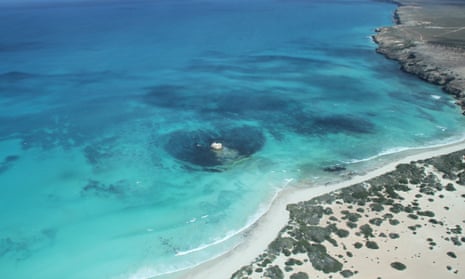BP’s publicly available plans to drill for oil in the Great Australian Bight don’t give a clear indication of where it would get all the people, boats and aircraft needed to contain a major oil spill in the remote waters 300km off the coast of South Australia, according to the Wilderness Society.
BP says it is confident its plans “are appropriate” but says “the regulator will ultimately determine if this is the case”.
BP has proposed to drill for oil inside a commonwealth marine reserve. Its first two environmental plans were rejected after the regulator found they did not meet its requirements. A decision about its third plan is expected to be made next week.
In the summary of its oil spill response plan, BP made clear physical containment strategies – such as booms and skimmers – were likely to be of “limited effectiveness” in the rough seas of the Bight, where the oil slick would be broken up by waves. But when BP was responsible for the world’s largest oil spill in the Gulf of Mexico in 2010, it heavily relied on these strategies, deploying thousands of kilometres of booms to contain the spill.
BP said in the Bight it would rely mostly on chemical dispersants. But it said those dispersants might not be deployed until 10 days after a spill, while some regions could get hit with an oil slick after just nine days.
After BP’s Deepwater Horizon disaster, more than 6,000 boats, 100 aircraft, 45,000 personnel and 17,500 National Guard troops were deployed. But BP’s publicly released plans for managing a spill in the Bight didn’t explain where it would source all that equipment and people.
In its short summary of what it would do if there was a major oil spill, BP indicated many of its planned containment strategies were unlikely to be effective at stopping oil from spreading.
It said it would need to rely on direct protection of shorelines in many cases. But BP said in the case of some parts of Kangaroo Island, that wouldn’t be effective, owing to the shoreline being “very exposed” and subject to very large waves.
The Wilderness Society said that meant Kangaroo Island’s west coast would likely be hit by an oil slick if there was a blowout.
BP insists they “will implement the most effective response strategies given the circumstances” and that “Kangaroo Island has been identified as one of five priority areas in the Great Australian Bight”.
Despite the Bight having very rough water and famously high wind speeds, BP didn’t make public any modelling of how often its containment strategies would be available to be used.
When it comes to protecting wildlife, BP said its first response would be to prevent them entering the affected areas or to capture and remove animals at risk.
The national director of the Wilderness Society, Lyndon Schneiders, said the document made public by BP was too short to count as serious consultation with the public. He said when Shell proposed to drill for oil in the Arctic it released a 438-page oil spill response plan.
“BP is treating Australians like mugs if the company thinks this flimsy document will wash given BP’s woeful performance in the Gulf of Mexico,” said Schneiders.
BP responded, telling Guardian Australia it was confident it had “consulted extensively and adequately, but the regulator will ultimately determine if this is the case”.
The Greens senator for South Australia Sarah Hanson-Young said BP’s response plan made for “sobering reading”.
“All this document really confirms is that there are neither the resources nor the planning in place to contain a serious spill,” she said. “If this is the best that BP can do, then I think it’s clear why the Gulf of Mexico spill was such a catastrophic disaster.
“The Great Australian Bight is a natural wonder and I hope Nopsema does the right thing here by rejecting BP’s application, once and for all.”
The Wilderness Society South Australia director, Peter Owen, said: “BP was responsible for the world’s biggest oil spill disaster, the Deepwater Horizon tragedy in 2010, when 800m litres of oil spewed into the Gulf of Mexico for 87 days.”
“Only about 25% of the oil was recovered, leaving half a billion litres of oil in the gulf. Millions of litres of toxic oil dispersants were sprayed into the Gulf’s waters. The spill and cleanup killed millions of fish, an estimated 800,000 birds and 75,000 dolphins and whales.
“Australia’s offshore oil and gas authority, Nopsema, must finally end this farce and finally reject BP’s application to drill in the Bight.”










Comments (…)
Sign in or create your Guardian account to join the discussion